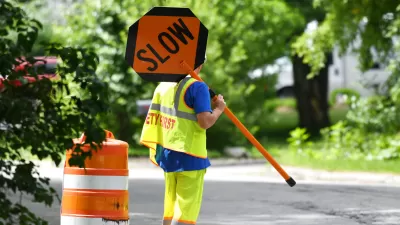Since the devastation of Hurricane Katrina, public transit in New Orleans has struggled to rebound. With few riders, service expansions can't be justified. But with diminished service, fewer view transit as a viable option.
"One of the difficult truths America learned when Katrina's floodwaters receded is that a sizable chunk of the city's population--one in four according to the 2000 census--lacks access to cars, filling the worn plastic seats of buses and streetcars instead. Even before post-Katrina revelations, however, it was no secret that the New Orleans Regional Transit Authority (RTA) lacked the resources to transport its riders reliably, many of whom worked in the hotels, restaurants, and hospitals at one end of the city's sprawling 350-square-mile footprint and lived at the other. Riders would be held captive in the thick hot heat of summers, waiting hours at a time for a single transfer. On rainy days, entrepreneurial peddlers worked the crowds of soggy commuters at the uncovered bus stops, selling umbrellas held together with electric tape.
The storm and the resulting exodus only exacerbated the RTA's woes. After flooding destroyed 200 buses and miles of streetcar track, the RTA had to deploy aging commuter castoffs from other cities. The city's historic, olive-green streetcars became no more than a symbol used by the city's tourist board. Riders who could afford to buy or borrow cars began to do so. Others took up biking or walking. Many did not return.
Three years after Katrina, the 124,000 daily riders who fed the system the coins it needs to keep running have dropped by 75 percent, to 31,000 daily riders. The RTA now finds itself caught in a chicken-or-egg conundrum, funded by a combination of farebox returns, local tax revenue, and federal grants tied to a large ridership. Until more people return home to New Orleans, the city can't improve the transit routes to get them there."
FULL STORY: Transportation’s Slow Ride to Recovery in NOLA

Planetizen Federal Action Tracker
A weekly monitor of how Trump’s orders and actions are impacting planners and planning in America.

Maui's Vacation Rental Debate Turns Ugly
Verbal attacks, misinformation campaigns and fistfights plague a high-stakes debate to convert thousands of vacation rentals into long-term housing.

San Francisco Suspends Traffic Calming Amidst Record Deaths
Citing “a challenging fiscal landscape,” the city will cease the program on the heels of 42 traffic deaths, including 24 pedestrians.

Defunct Pittsburgh Power Plant to Become Residential Tower
A decommissioned steam heat plant will be redeveloped into almost 100 affordable housing units.

Trump Prompts Restructuring of Transportation Research Board in “Unprecedented Overreach”
The TRB has eliminated more than half of its committees including those focused on climate, equity, and cities.

Amtrak Rolls Out New Orleans to Alabama “Mardi Gras” Train
The new service will operate morning and evening departures between Mobile and New Orleans.
Urban Design for Planners 1: Software Tools
This six-course series explores essential urban design concepts using open source software and equips planners with the tools they need to participate fully in the urban design process.
Planning for Universal Design
Learn the tools for implementing Universal Design in planning regulations.
Heyer Gruel & Associates PA
JM Goldson LLC
Custer County Colorado
City of Camden Redevelopment Agency
City of Astoria
Transportation Research & Education Center (TREC) at Portland State University
Jefferson Parish Government
Camden Redevelopment Agency
City of Claremont





























